What is it?
This is the next generation MK4 CUPRA Leon, taking the reins from the MK3 SEAT Leon CUPRA that is our community’s most popular model.
This is the first ever CUPRA hybrid car, the DSG eHybrid with a 1.4-litre TSI petrol engine, combined with an 85KW electric motor.
With a combined power output of 245 BHP, it’s down on power over the previous generation that topped out at 300 BHP (we’re not comparing with the 310 CUPRA R’s ST here).
This CUPRA Leon hybrid has a speed of 0-62 in 6.7 seconds (7 seconds for the ST) and a top speed of 140 MPH. The previous generation DSG Leon CUPRA had a 0-62 time of 5.7 seconds.
Thankfully, we will have engine power matched with the forthcoming 300HP (hatchback) and 310HP (4-drive ST) models on the way by April 2021.
For now, CUPRA have chosen to launch the lower powered hybrid and its not been getting great reviews from the press. We’ve had half-a-day with a left-hand drive model in the UK.
Read on to find out if we think is worthy of the CUPRA badge or if SEAT should have launched it as a warm FR.
Verdict
A necessary step for CUPRA, clever technology, not a bad car, but depending on your needs you’re probably best waiting for the petrol models if you want to drive with a grin on your face.
What we liked
- Torquey
- Comfortable seating and driving position
- Bucket seats
What we didn’t like
- Sound actuator is too intrusive
- Removal of important physical buttons and dials
- Huge wheel arch gap
Exterior
Just before its full unveiling, CUPRA teased the CUPRA Leon with a carefully lit image that got fans excited. It looked mean and aggressive.
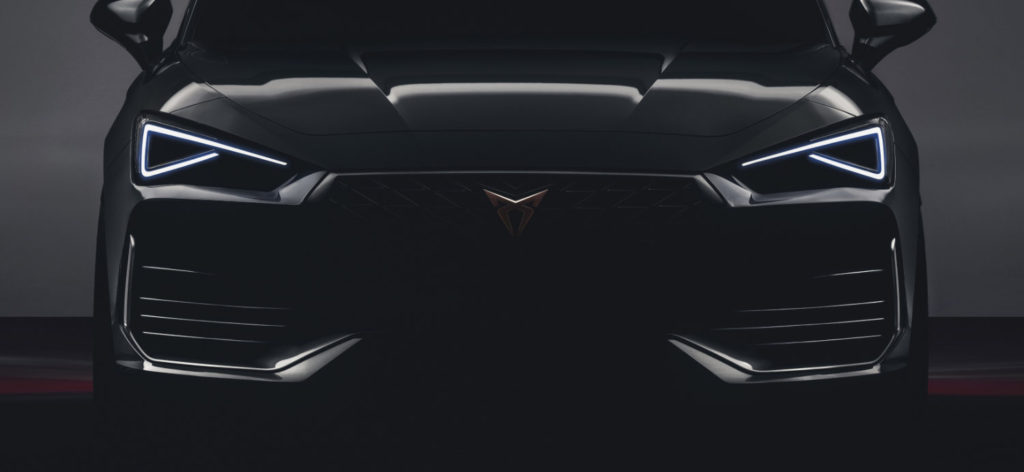
The full unveiled version is a bit disappointing compared to what certainly I expected and was hoping for. It is stylish, but its lost the aggression from the previous generation MK3 Leon CUPRA facelift.
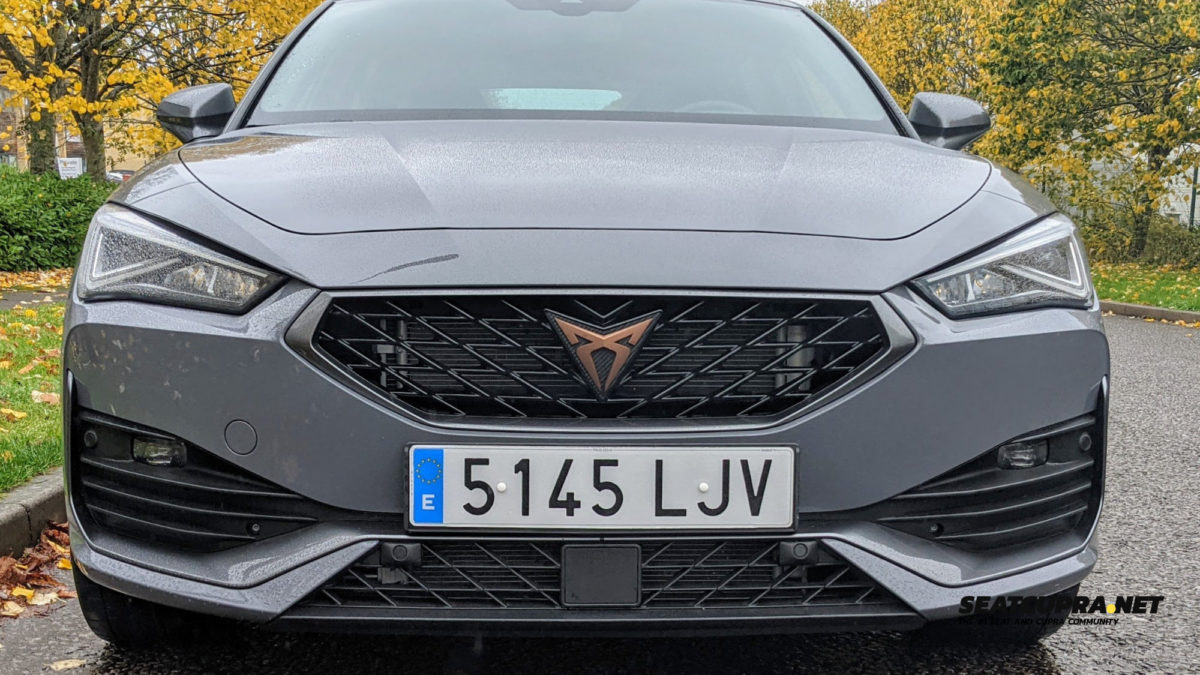
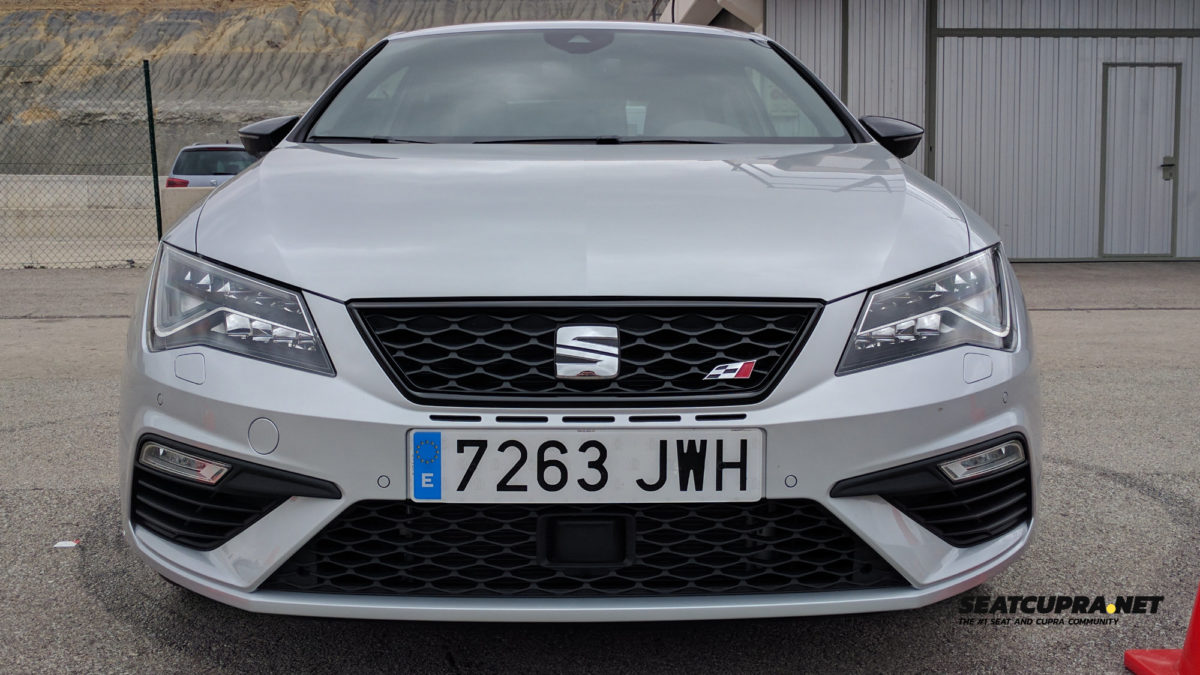
The colour we are looking at is Graphene Grey (metallic), first introduced to the range on the CUPRA Ateca Limited Edition. Other colours available are as follows: white non-metallic paint and four other metallic colours (Desire Red, Magnetic Grey, Midnight Black, Urban Silver) at no extra cost.
While we’re here, a lot of people say the new Leon looks like the Focus. What do you think?
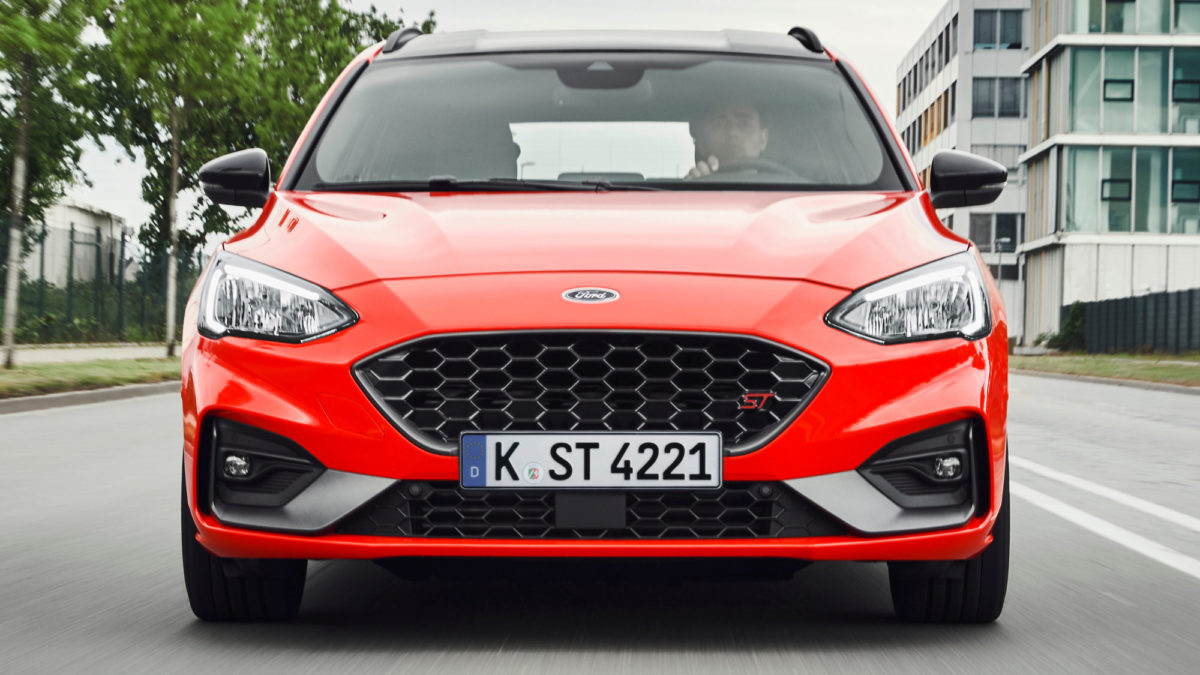
At the CUPRA Leon launch earlier in the year we were told by the (now departed) car’s designer that there are limitations on how much freedom they had with the front of the car due to regulations imposed for pedestrian safety. This explains why there are similarities to the focus and other makes in this class.
The front of the CUPRA Leon is similar to the standard Leon as you’d expect with the shaped bonnet with two raised lines running down towards the central badge.
The overhanging bonnet meets the same inset narrow headlight arrangement. The centre grill features the CUPRA badge and a ziz-zag gloss black design, the same as the CUPRA Formentor. The grill surround is also the same with a grey/silver gloss plastic.
Moving down the bumper the design is similar to the standard Leon except it is flatter, whereas the standard Leon has raised edges that sticks out and adds more shape. Here’s where I think the styling is better on the standard Leon over the CUPRA, and it gives it a bit more of an aggressive look. It’s like they are the wrong way round. You can see what I mean below.
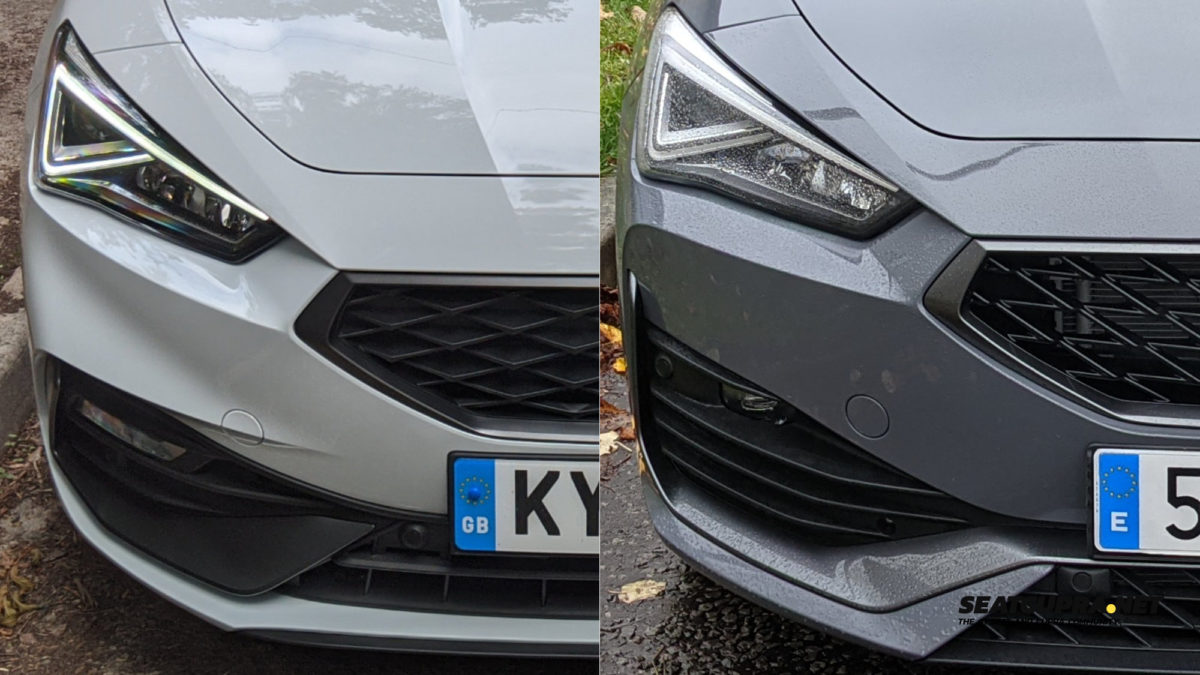
Below that we get one fin above the fog light and then three below, as opposed to one above and two below on the standard SEAT Leon FR.
Below the number plate the lower grill design matches the upper one with the ziz-zags again (this is the best way I can describe it!)
In the centre is the square radar sensor.
Finally, at the bottom there is a black lower splitter as opposed to the body coloured one on the SEAT Leon FR.
Moving on to the side this is where the car is more striking than its predecessor and looks just that bit more modern.
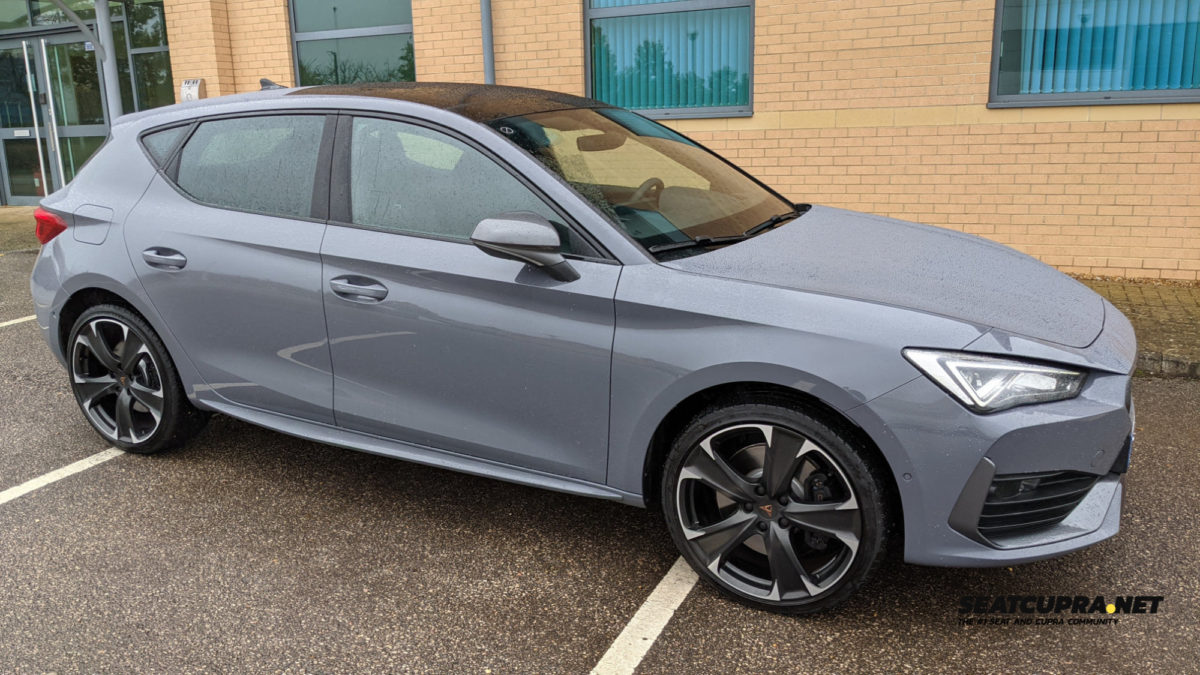
I think the wheels on this car are a step down from the facelift MK3 Leon CUPRA. The ones on this car have a two-tone silver and matt black design, but this time there are several wheel options to choose from depending on the trim you choose.
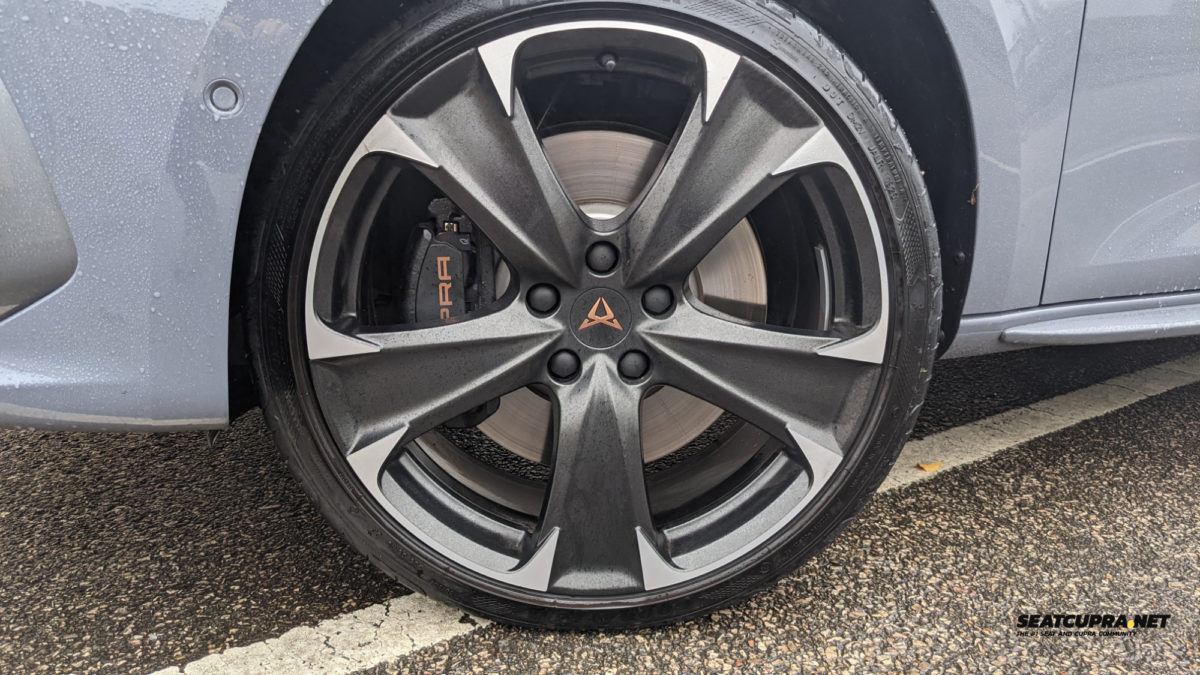
When the car was first revealed we were told that Brembo brakes would be as standard. They are clearly not on this car. It is probably felt that the lower powered car doesn’t need them.
However, the petrol versions will feature 370mm Brembo brakes, hopefully as standard but we will have to see.
From the side view the front nose looks quite aggressive with the inset narrowed lights and the fin that curves upwards from the lower bumper.
A line starts at the edge of the light and runs past the front door to just before the rear door handle. As you can see in the picture this casts a shadow below where the electric charging point cover sits.

The line then continues again, starting above the middle of the rear wheel and curves round to the back.
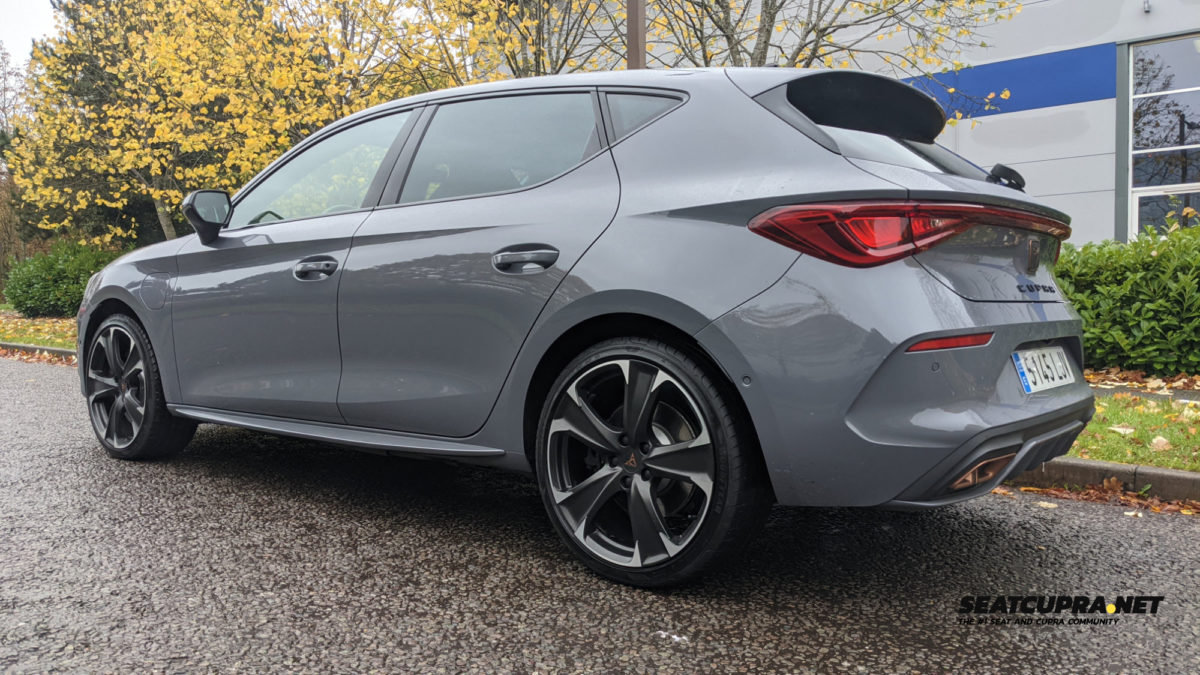
There is another line that starts at the bottom of the front door and slowly curves up to 3/4 of the height of the rear wheel stopping short again just before the rear door handle.
We also get standard side skirts which is good to see, as on the previous generation they were only found on the CUPRA R / Carbon models or as an optional extra to the CUPRAs.
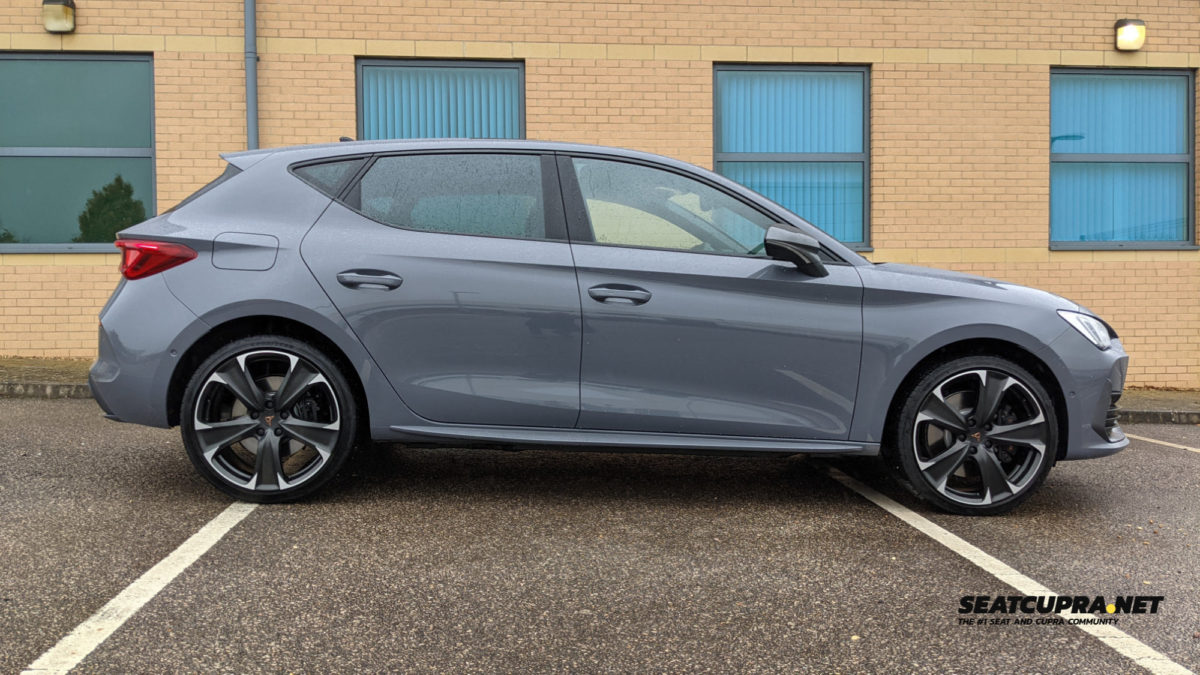
The MK3 looks a little bit “boxier” in comparison to the MK4 which I think just looks a bit sleeker from the side.
Moving around to the rear the most striking part is what SEAT and CUPRA call “Coast-to-coast” lights. We’ve got a short video of these in action at night in the MK4 SEAT Leon review.
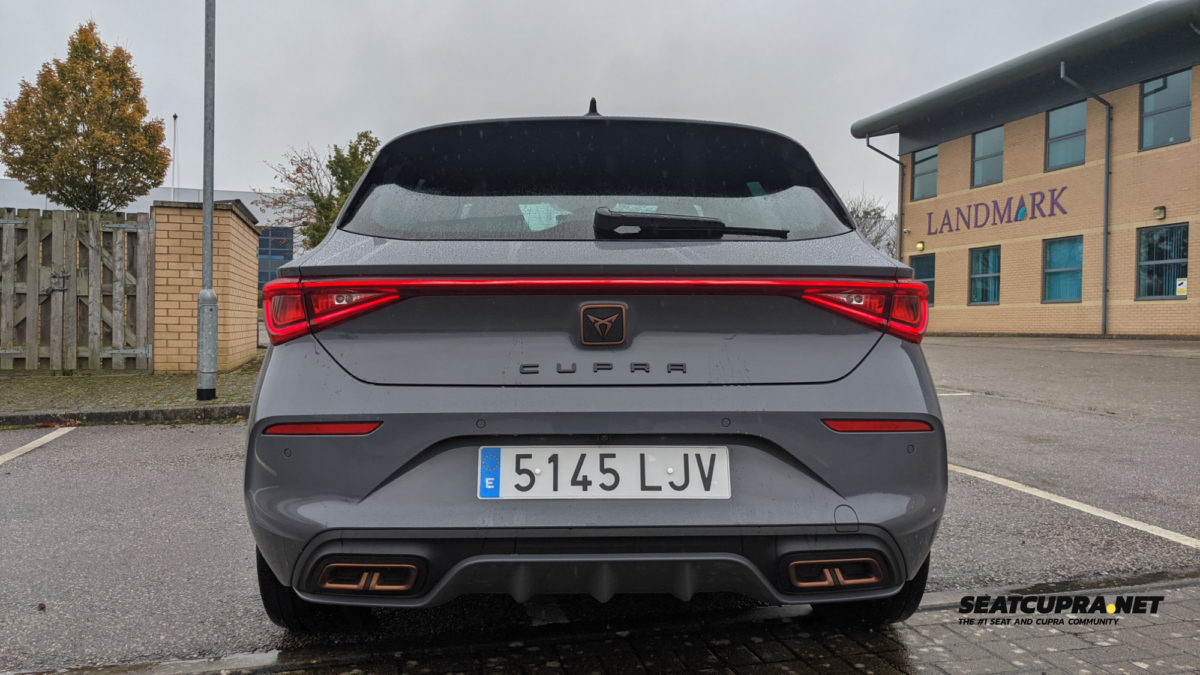
The spoiler is a reasonable size but can look smaller than it is from certain angles due to the gloss black fins that widen at the top. Looking at the car directly from the back however it casts a good shadow over the rear window.
There is no brake light below the spoiler, that is all taken care of in the central light strip.
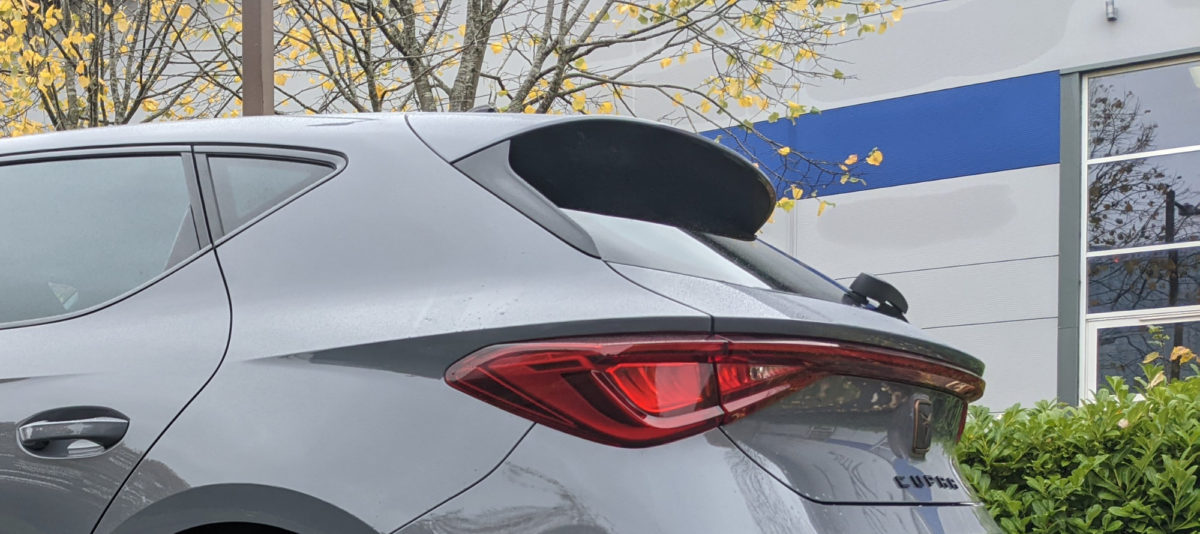
The window slopes down to the extended lower lip that looks like a second spoiler and features the light strip.
This overhangs quite considerably and creates a cool shadow effect, and looks particularly good at night (again see our MK4 SEAT Leon review).
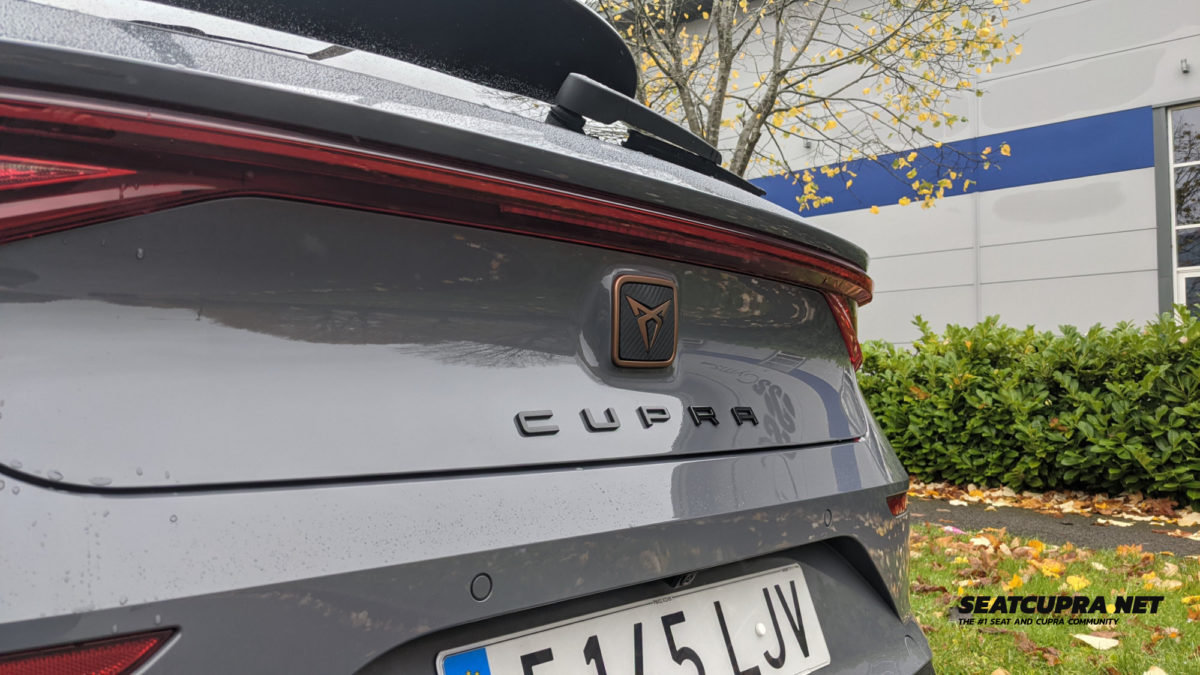
The SEAT badge is of course replaced with the CUPRA logo (which is also the boot latch) and the CUPRA lettering below in gloss black in the familiar font from the previous generation. Please never change this font CUPRA like SEAT have with the new Leon and Ateca facelift! it’s one of the only things that has carried over from the pre-rebrand SEAT CUPRA era and it still looks modern.
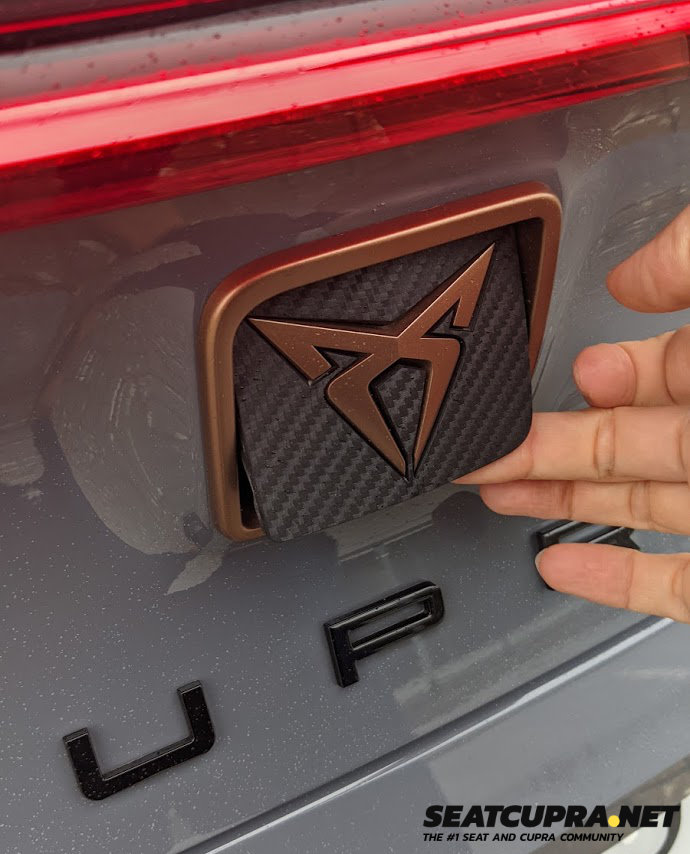
The reflectors sit quite high along the second raised part of the bumper creating another overhang and shadow above the number plate.
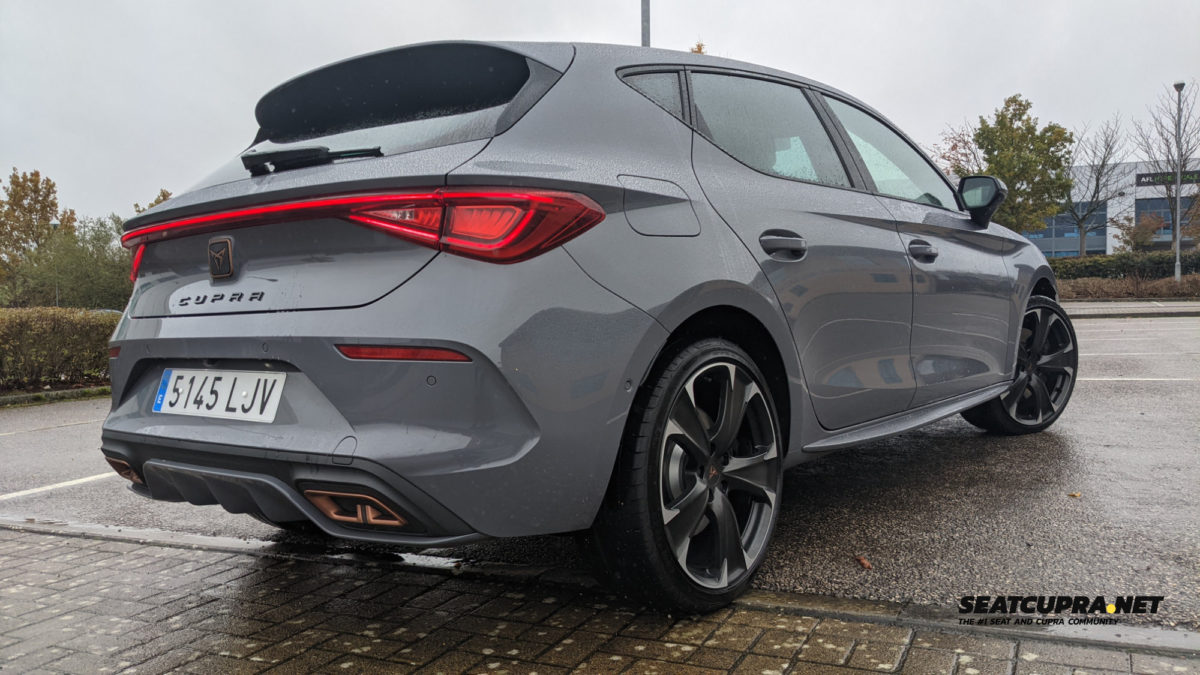
This area is body coloured. It’s a shame the black has gone from this area as per the previous generation models, it doesn’t look too bad, but it would have looked better in black, I think.

Below this we come on to the exhaust housing area in dark grey plastic, well, fake exhaust housing area. This is where on the petrol cars we will see the real exhausts pipes, quad on the ST, and potentially quads as well on the 5-door hatch, despite what we were told at the car’s press launch being twin only (check out the video later in the review, as I found something hidden in plain sight in the infotainment unit).
There are two plastic copper surrounded fake exhaust outlets which signifies the eHybrid model. What do you think about them? let us know in the comments below.
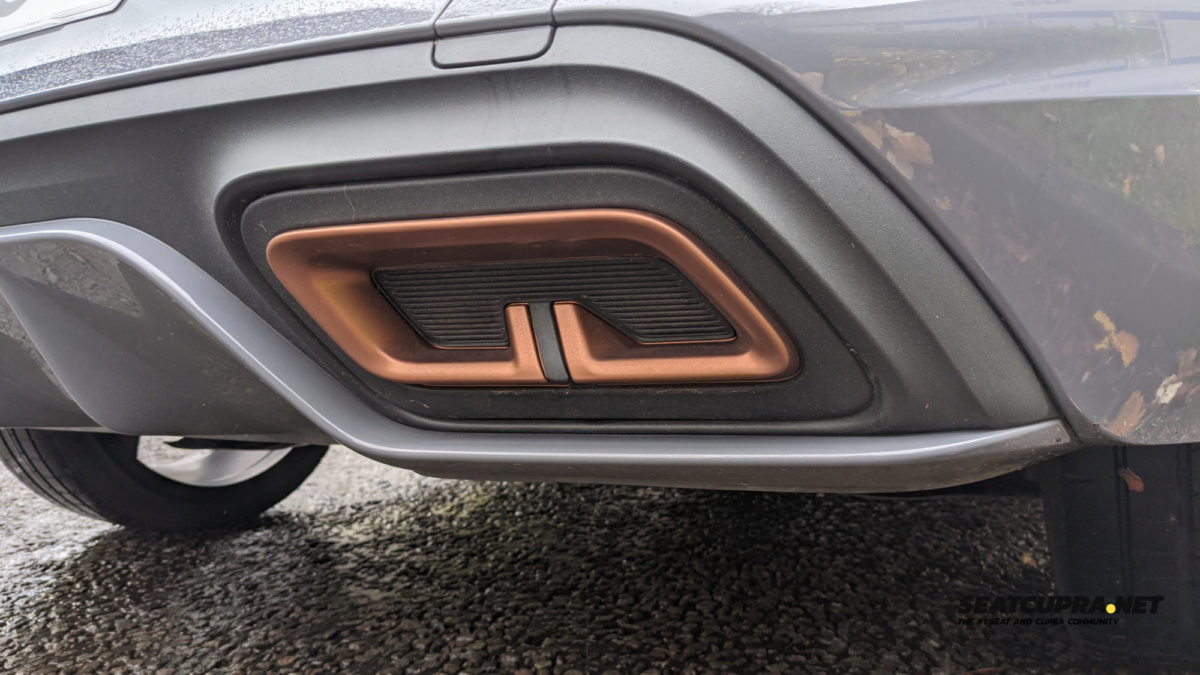
Between the exhausts there is a lower diffuser with three fins in the light grey accent colour, the same as is featured on the lower part of the front bumper. Again, on SEAT CUPRA models these have traditionally been black plastic. I wonder if people will be wrapping or painting these in gloss black when they get their cars.
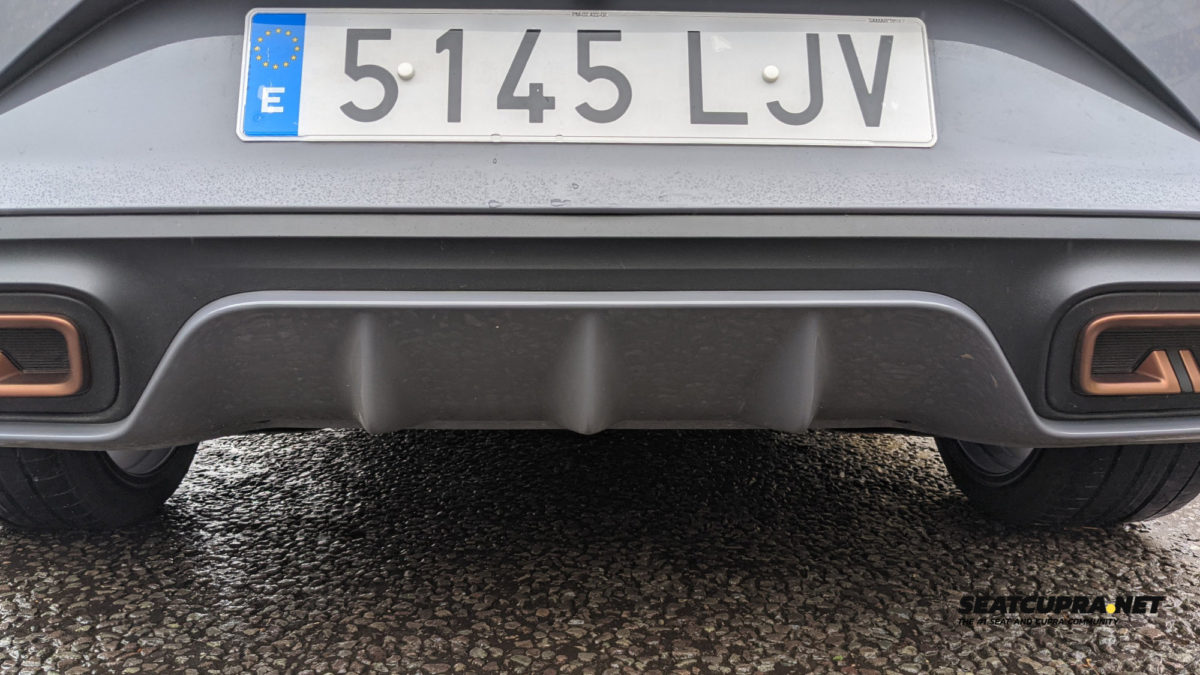
Interior
The interior is nice and comfortable and very similar to the CUPRA Formentor.
SEAT and CUPRA have always done ergonomics well. The driving position is comfortable, everything is within reach, visibility of the dashboard screen is great, and driving visibility is good.
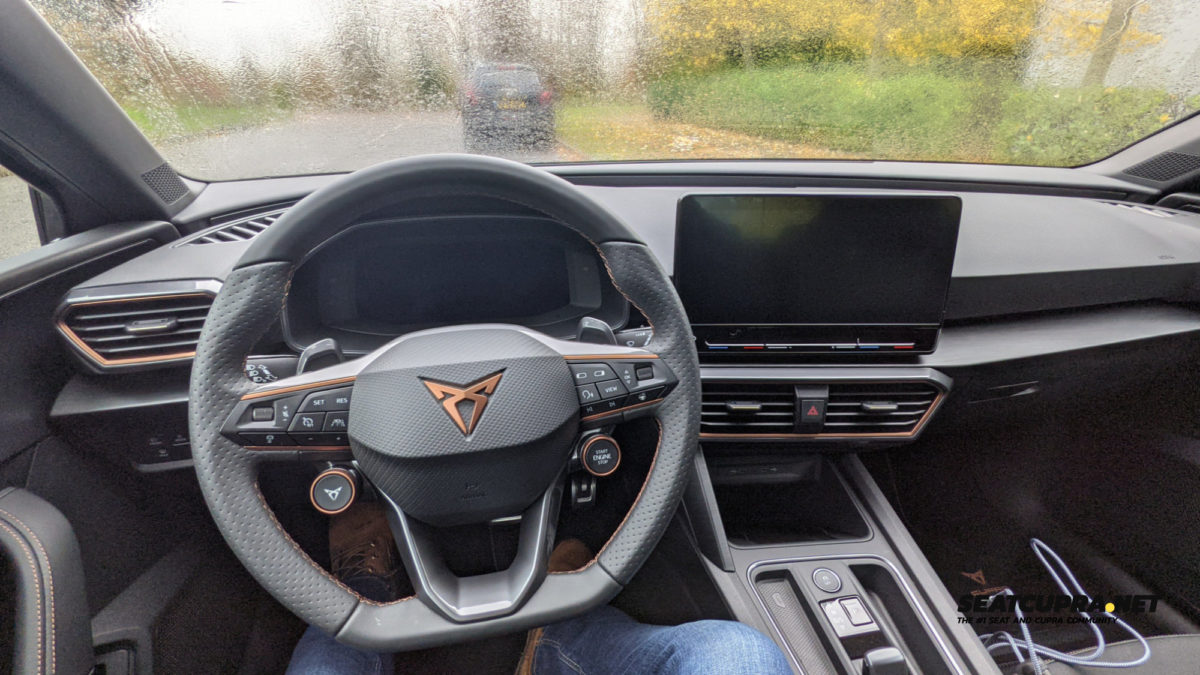
In what is going to be a recurring theme in reviews going forward I fear, I’m going to have to complain again about the removal of physical buttons for the important stuff you shouldn’t have to look at to adjust. I’m not alone and many other reviews of SEAT and VW cars, as well as other makes beyond the group, are not happy with this trend. I do hope we see this move reversed in future generations. I called it “driver hostile” in the MK4 SEAT Leon review, and it’s no different here.
The steering wheel is the same as the Formentor’s and at least does have proper tactile buttons there, the Golf doesn’t. The wheel is nice to hold and has the same shape as the previous generation, grippy tops and a flat bottom. One mild annoyance is the media buttons have been moved to the right-hand side of the wheel where I’m used to them being on the left on all previous cars, so I kept pressing the set and reset controls for the cruise control instead of skipping back and forward between tracks. It’s something you’ll get used to eventually I’m sure.
The start button is on the wheel and not the centre console which houses the short DSG gear lever and the ESC button which I mistook for the engine start/stop button far too many times!
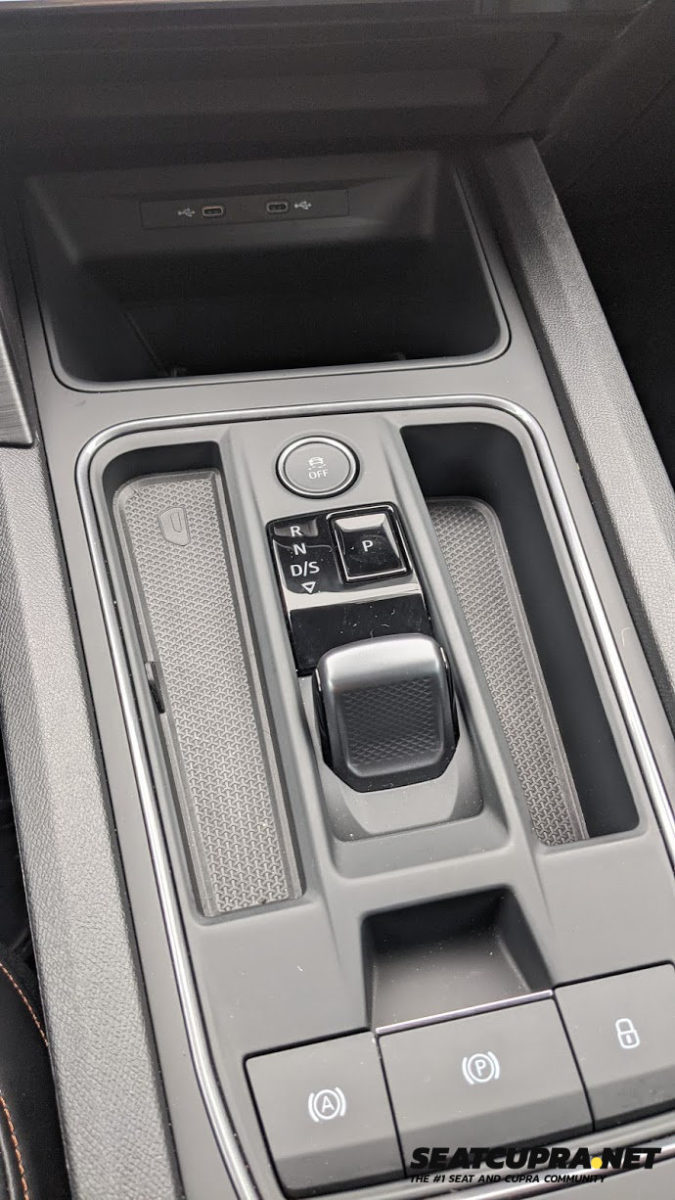
The lighting buttons are the same as the standard Leon and Formentor again – terrible touch control plastic. The part looks like it cost about 50p to make. Give us proper buttons back! (ok button rant over I promise).
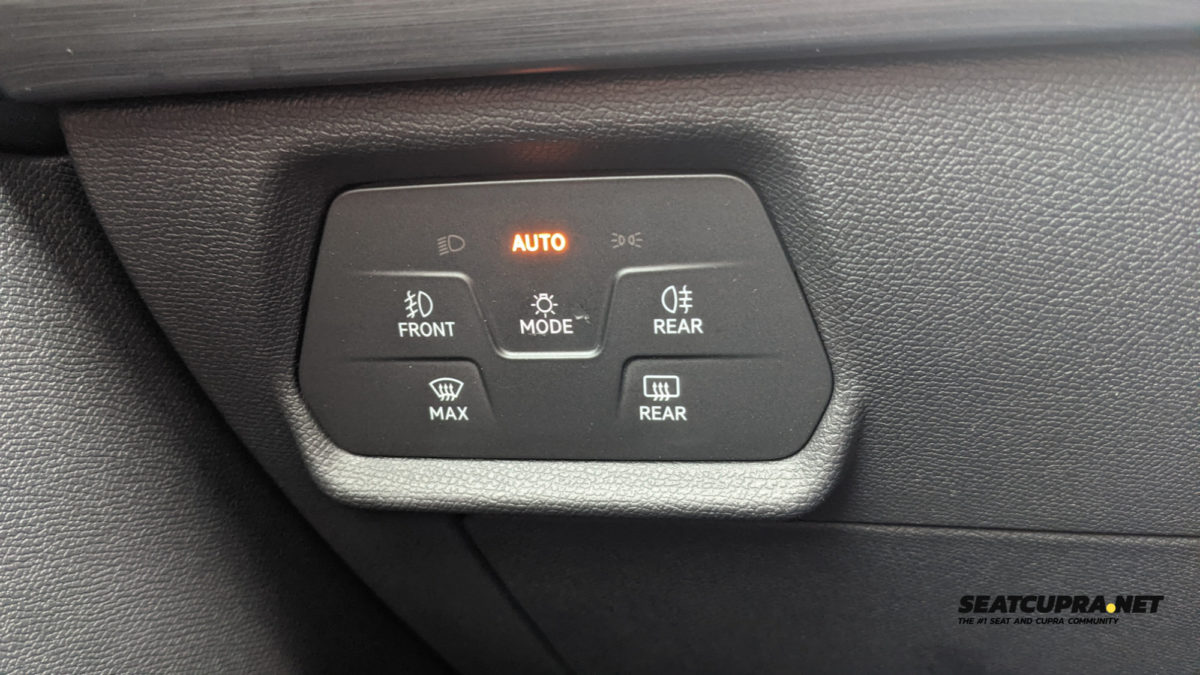
The air vents are surrounded in copper and the same plastic aluminium coloured ledge runs across the centre of the dash.
The car has the digital cockpit as standard with Full Link integration (wireless Apple CarPlay and Android Auto) and has the 10-inch infotainment screen.
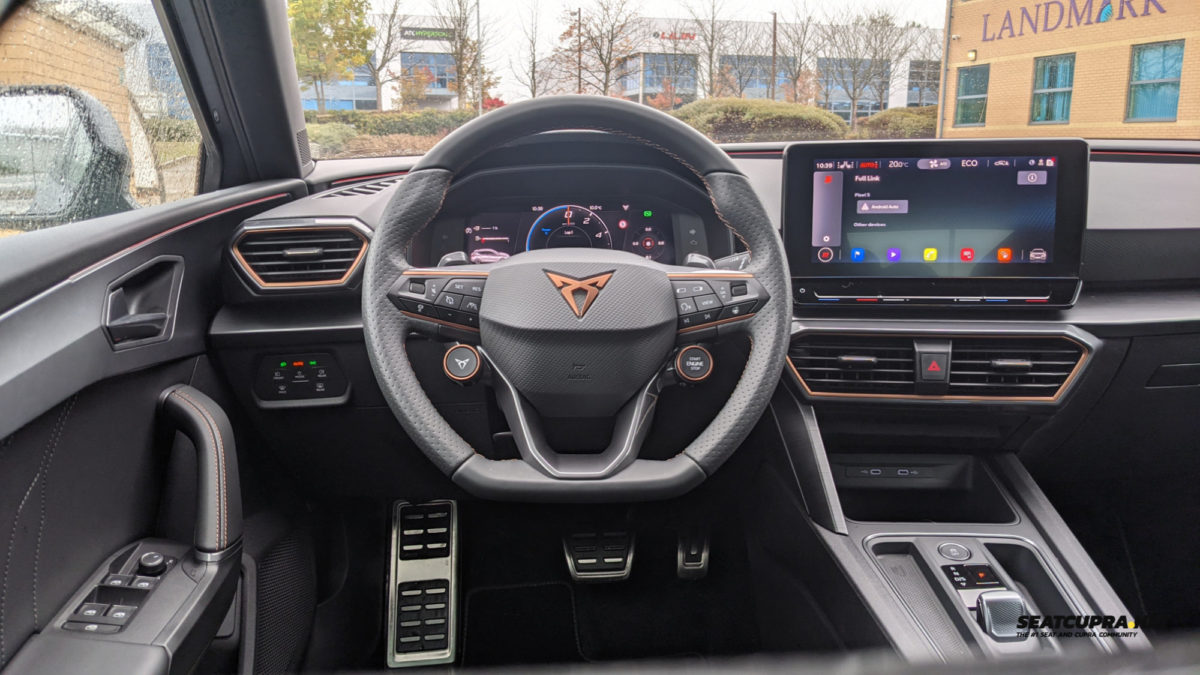
The interior features the wraparound lighting including the warning when cars are passing indicated by an amber light. This was cool to see as I was parked, and cars were driving past.
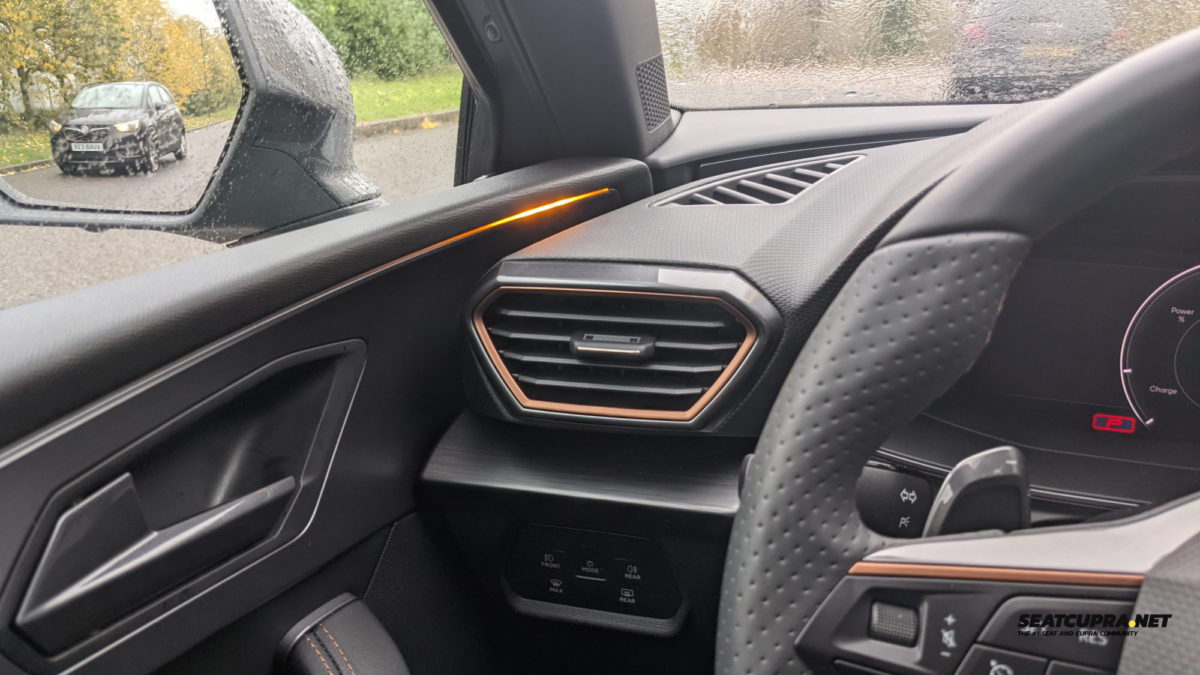
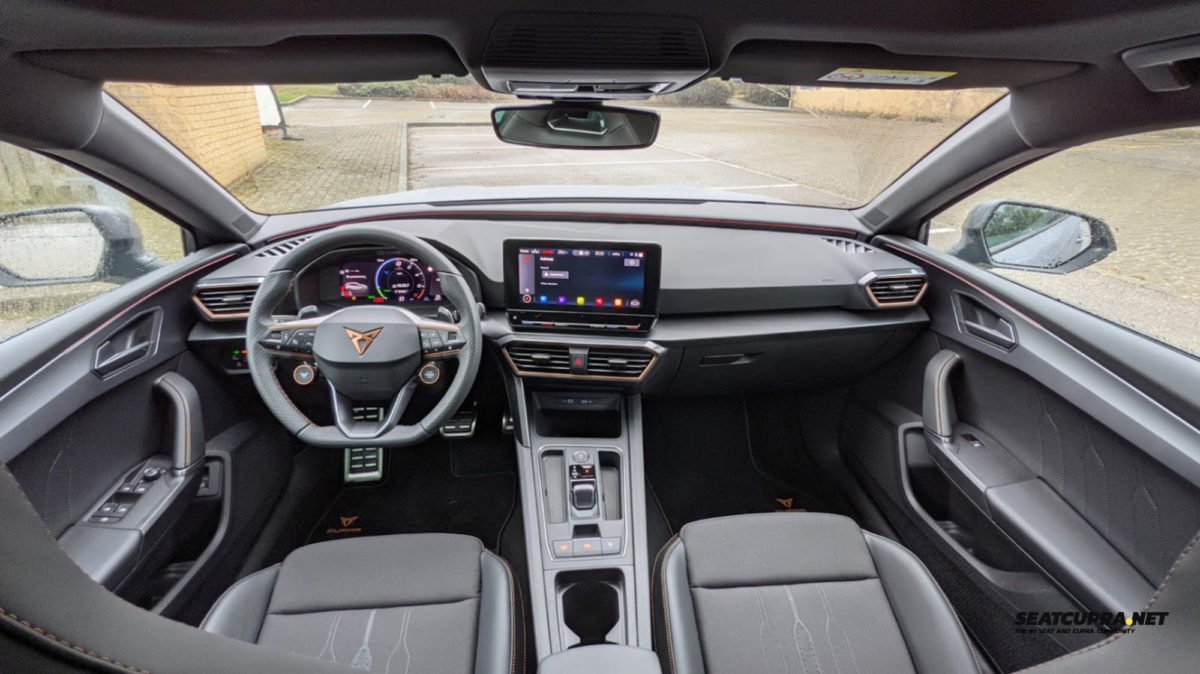
The bucket seats are comfortable and supportive. I still wish they were available with Alcantara. I miss that from the MK3 CUPRA Leon.
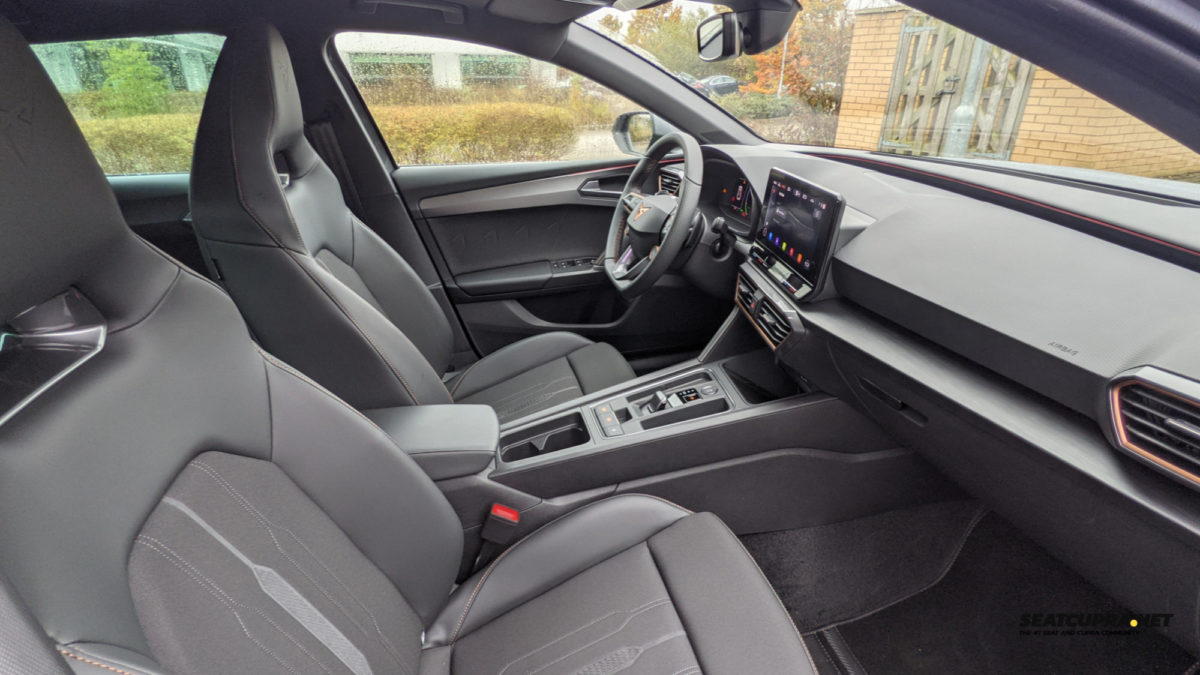
The car comes with CUPRA mats and the door sills feature CUPRA lettering with white LED lighting.
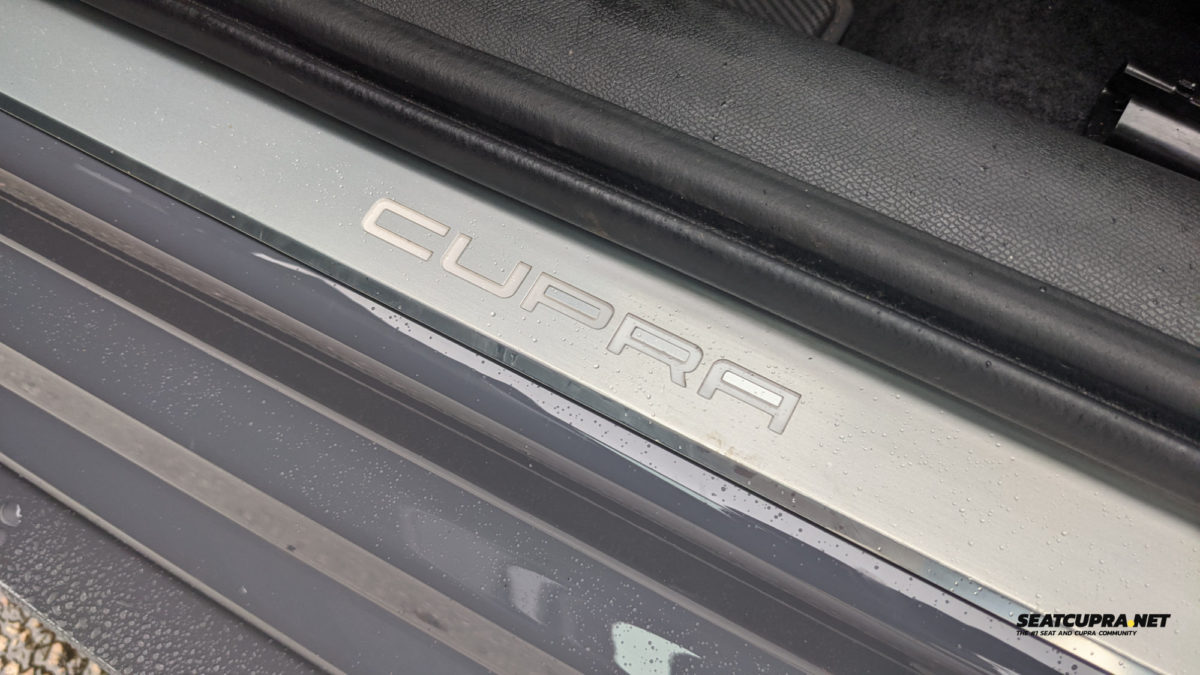
The rear provides plenty of leg room, a bit more than the previous generation and the seats are comfortable with the usual central pull-down arm rest with access to the boot.
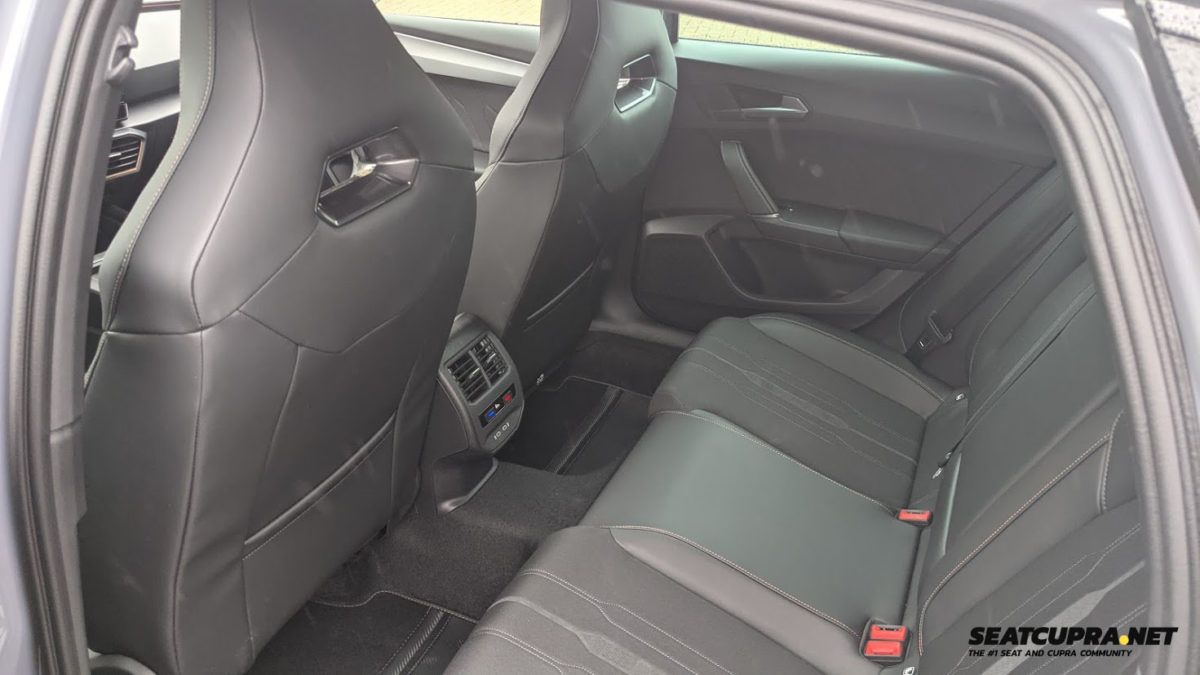
Rear passengers have their own climate control and two USB C sockets, in addition to the two found under the central dash in the phone charging tray.
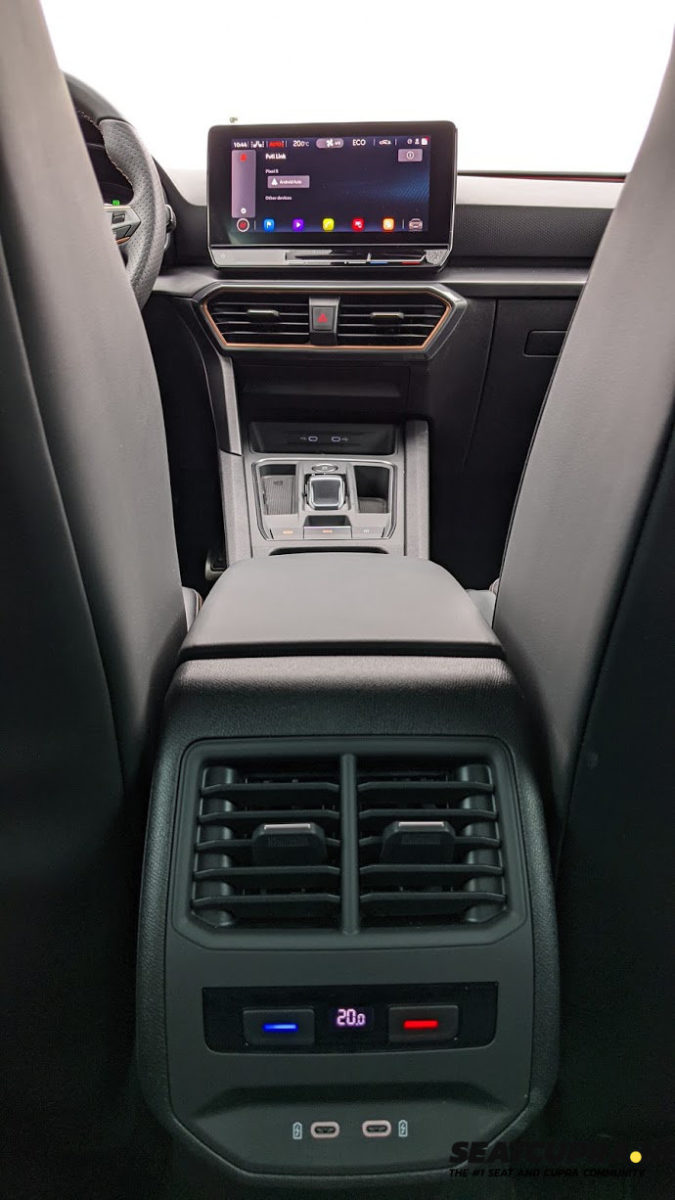
In the rear there are touch sensitive LED lights in the roof lining which I discovered by accident and they are kind of cool.
Boot depth is compromised over the standard petrol SEAT Leon due to the extra space needed for the eHybrid gubbins. You’ll also need some of the space for the charging cable which is included.
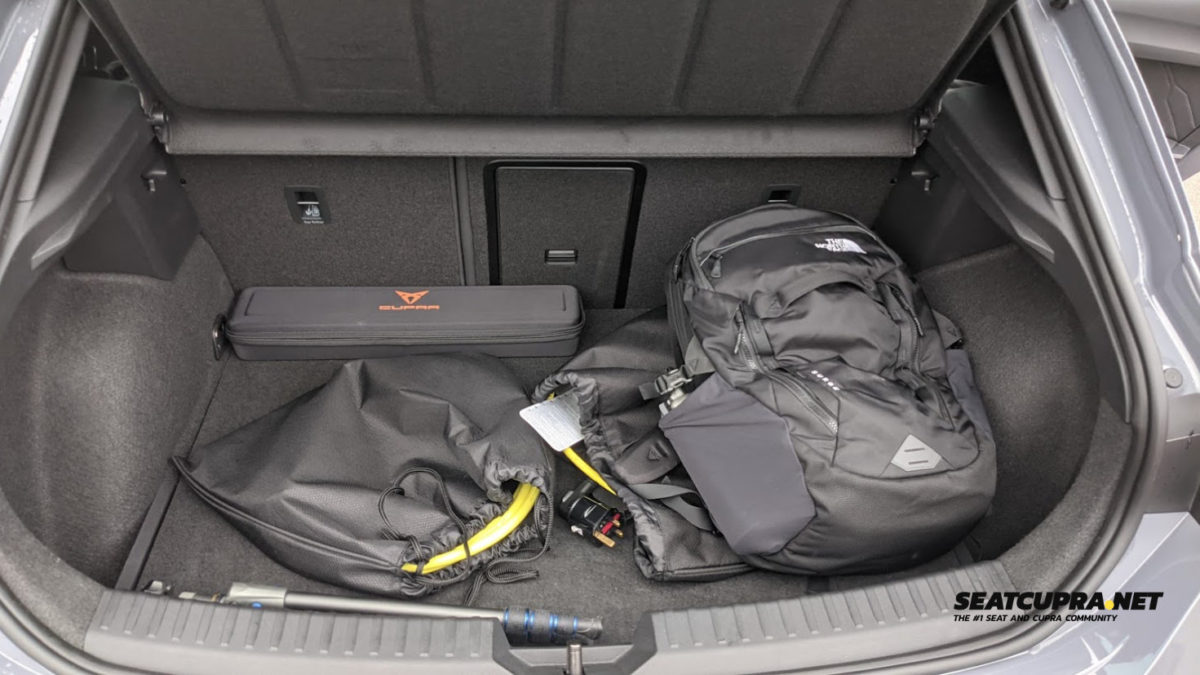
Driving and Performance
This car has been getting a bit of a slating in the press for being compromised and I expected to be really disappointed with the performance and handling as a result.
It’s the first electric car I have driven and most of my car ownership is in SEATs and CUPRAs so I’m giving you this perspective with that in mind.
I thought it was fine. It was fast enough for most people and handling (bearing in mind I was on public roads, in the wet, sticking to the speed limit) was ok. It did feel quite torquey off the line, which was fun, a bit of wobble in the wheel when flooring it but the conditions on the road weren’t ideal so we’ll cut it some slack.
You can feel the extra weight in the car compared to the MK3 CUPRA Leon, but the acceleration felt good enough, again for most people.
The car gives you the option to drive in two modes. The first one, “E-MODE” is where it is in electricity only mode. Sadly, the battery was flat before I decided to try driving in in this mode, so I didn’t really get to experience that other than low speed manoeuvring. In this mode the car will switch the combustion engine on if the power is not enough or the battery is empty.
The second mode is “Hybrid” where the two power modes work together and used navigation data as well as how you are driving to control the optimum performance.
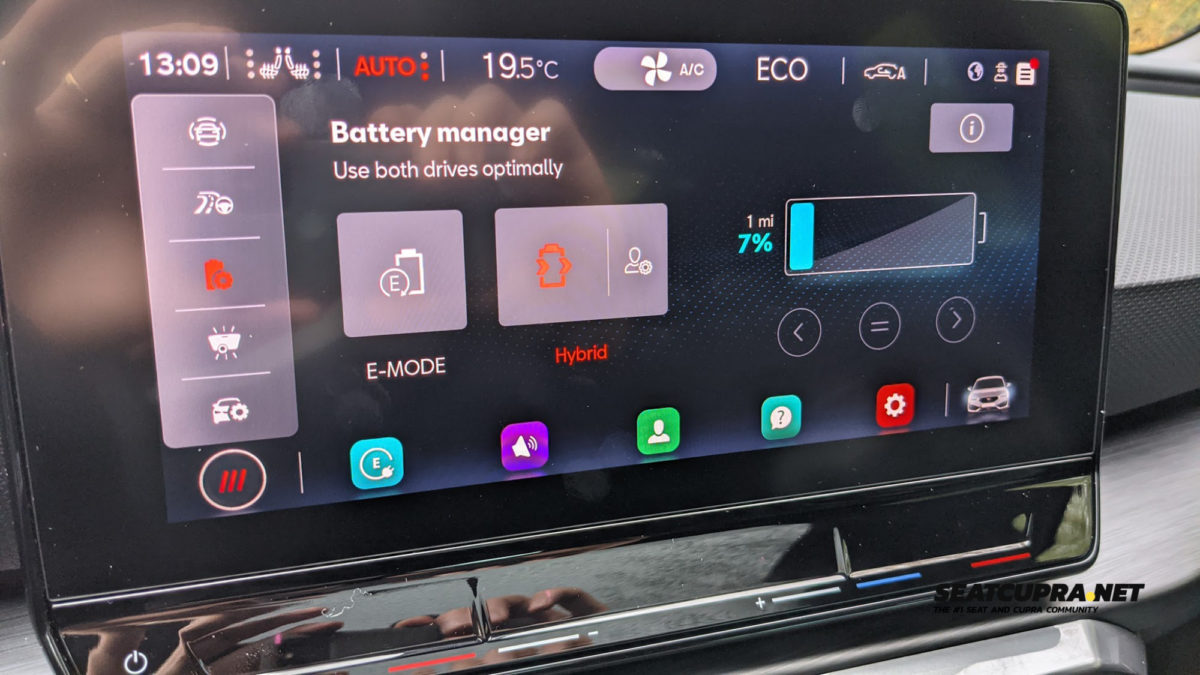
Check out the quick video tour of these modes below and wait for the surprise discovery I mentioned earlier…
We need to talk about the sound actuator. For those who don’t know what these are they play synthetic engine sounds into the cabin. The settings on this one makes it intrusive and feels like overkill for the car. I guess it’s trying to make it sound super sporty, but it’s just a bit too much for my liking.
I can see the attraction of having the best of both worlds, but the consensus amongst many is that PHEVs offer the worst of both worlds. I only had a few hours with the car so can’t comment on long term use and what it will be like to live with. We hope to have more time with the car in a few months when RHD press cars become available.
The car claims 0-62mph in 6.7 seconds and that felt about right to me.
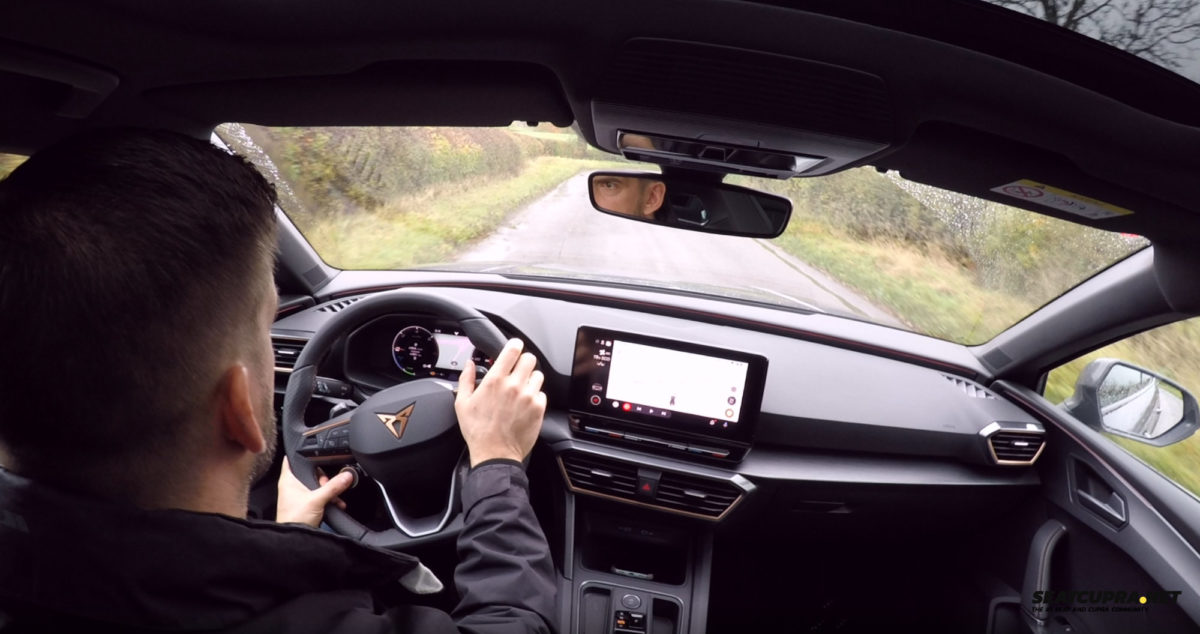
The dynamic chassis control gives you the option to change your suspension settings and I have to say, again due to the brief time I had with the car, I kept it in CUPRA mode most of the time. Being the same chassis as the previous generation it felt familiar, not crashy, and comfortable enough for Britain’s roads. I expect the comfort setting will add that extra level of comfort for the motorways as those with the MK3 will be used to.
There’s not much more to say about the performance and handling to be honest. It’s ok, I’d even go so far to say it’s good. Just not “wow I’ve got to have this car” good.
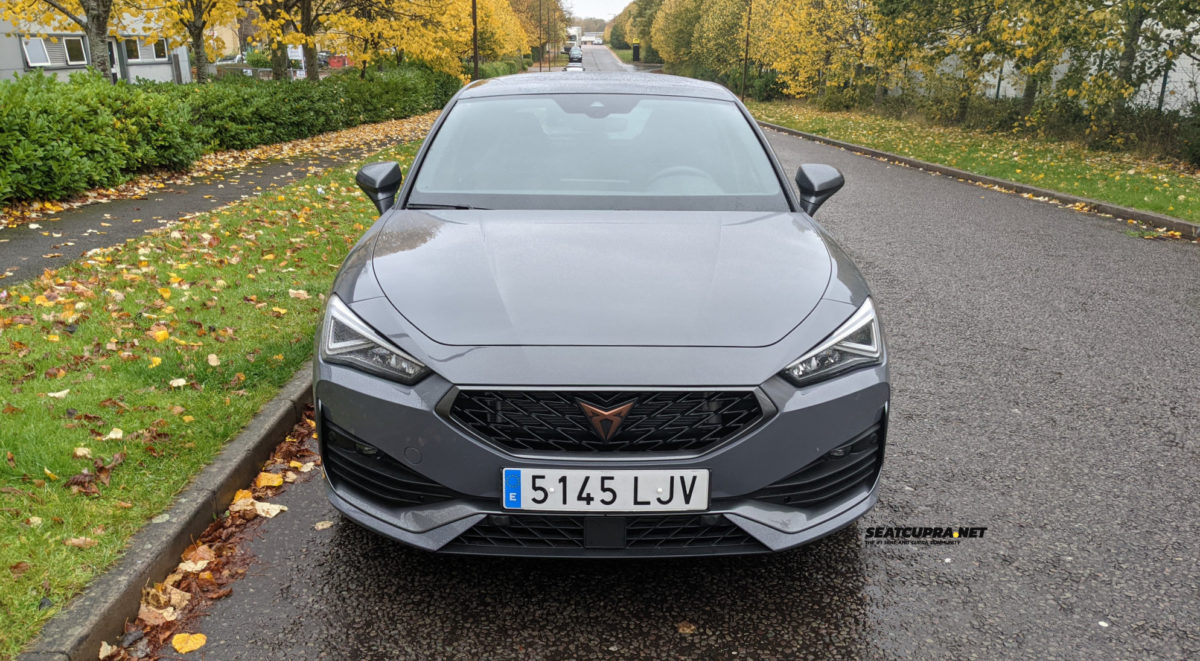
Last thoughts
As I said earlier, I expected to be disappointed with this car after reding the other reviews. I was surprised I wasn’t. I wasn’t wowed, but I wasn’t disappointed either. This sets the baseline for what the 300HP and 310HP (ST) petrol versions will be capable of. With the reduced weight and more power over this model.
This car is a necessary car for CUPRA to take their first step on their electrification journey. For a first step, it’s good enough. It’s reported VW’s technology in this space is years behind Tesla so they have some catching up to do and we’ll look forward to driving the CUPRA e-lborn next year.
This car isn’t for me, but I know that the same car with the 300HP petrol will be (partially because straight after driving this car I was hooning around in the 310HP Formentor).
If you are waiting for the petrol CUPRA Leons, did you spot the surprise reveal about the 5-door hatch in the video above?
Is this car for you? Only you can decide that. Try one yourself first before ordering if you can, and if you do, let us know in the comments below what you think.
A summary of the editions and pricing for the eHybrid can be found in the table below. For more details view the full pricing and specifications article.
Deliveries to the UK begin before the end of the year (2020) for plug-in hybrid variants and Q1 for pure-petrol models.
Stay tuned, we’ve got three more car reviews on the way between now and December.
New CUPRA Leon 5DR
| Model | CO2 (g/km, WLTP) | Fuel econ. (mpg, WLTP) | BiK | Price (OTR) |
| VZ2 | 30 | 201.8-217.3 | 10% | £34,495 |
| VZ3 | 30 | 201.8-217.3 | 10% | £36,225 |
| First Edition | 30 | 201.8-217.3 | 10% | £35,775 |
New CUPRA Leon Estate
| Model | CO2 (g/km, WLTP) | Fuel econ. (mpg, WLTP) | BiK | Price (OTR) |
| VZ2 | 31 | 188.3-201.8 | 10% | £35,525 |
| VZ3 | 31 | 188.3-201.8 | 10% | £37,585 |
| First Edition | 31 | 188.3-201.8 | 10% | £37,240 |




